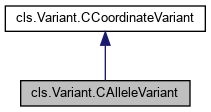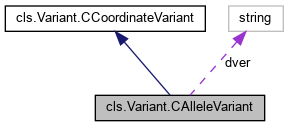Minimalistic form of a variant. More...
Inheritance diagram for cls.Variant.CAlleleVariant:

Collaboration diagram for cls.Variant.CAlleleVariant:

Public Member Functions | |
| def | __init__ (s, dver, gc, ref, alt, strand="+", rsID="", normalize=True) |
| Constructor. More... | |
| def | __str__ (s) |
| def | __eq__ (s, obj) |
| The equality operator. More... | |
| def | IsChanged (s) |
| Have the input data changed during normalization? More... | |
| def | GetDBSNPID (s) |
| Get dbSNP ID. More... | |
| def | Reverse (s) |
| Generate an object for the reverse strand. More... | |
| def | Original (s) |
| Get an object with the original, unnormalized data. More... | |
 Public Member Functions inherited from cls.Variant.CCoordinateVariant Public Member Functions inherited from cls.Variant.CCoordinateVariant | |
| def | __init__ (s, dver, gc) |
| Constructor. More... | |
| def | IsValid (s) |
| Is this a valid object? More... | |
| def | GetChrom (s) |
| Get the chromosome name. More... | |
| def | GetStart (s) |
| Get the start coordinate of the variant. More... | |
| def | GetEnd (s) |
| Get the end coordinate of the variant. More... | |
| def | GetBuild (s) |
| Get the build version. More... | |
| def | GetCoordString (s) |
| Get the coordinate string of the variant. More... | |
Static Public Attributes | |
| string | dver = "v-37"; |
| obj = CAlleleVariant(dver, "GRCh37:22:42524203-42524206", "AGTC", "-"); | |
Detailed Description
Minimalistic form of a variant.
This class attempts to represent variants in a minimalistic, normalized form. Given the many possibilities to represent a single variant, it is clear that there is no unique way to accomplish this. The class has been designed to accept input from VCF-derived variants (eg. ClinVar), Ensembl, and HGMD, which returns the mutation on the reading strand compared to dbSNP, which almost always refers to the forward strand. Instances of this class can be compared with the @c == operator, which is one of the main goals of its implementation. Comparison depends on the objects to be compared. If the objects belong to the same class, the __eq__ method is called for this class. However, if object @c a and @c c are instances of CAlleleVariant and CCoordinateVariant, respectively, the comparison operator of the less specialized class will be used (that is CCoordinateVariant in our case). Given a variant, we remove redundancy by chopping basepairs from the 5' and the 3' termini. One should especially be aware that using this class for an insertion with a reference string (especially useful if it indicates the reverse strand), there will be information loss due to normalization.
Constructor & Destructor Documentation
◆ __init__()
| def cls.Variant.CAlleleVariant.__init__ | ( | s, | |
| dver, | |||
| gc, | |||
| ref, | |||
| alt, | |||
strand = "+", |
|||
rsID = "", |
|||
normalize = True |
|||
| ) |
Constructor.
- Parameters
-
dver Data version Stringfor config file lookup.gc Genomic SNP coordinate. ref Reference allele. Since we do not have access to genomic data from Python, this is not check for correctness. alt Alternate allele. strand Reference strand, can be either '+'or'-'.rsID dbSNP ID, if known. This will not be used in the comparison operator. normalize If set to False, do not attempt to find a minimalistic representation of the variant.
Member Function Documentation
◆ __eq__()
| def cls.Variant.CAlleleVariant.__eq__ | ( | s, | |
| obj | |||
| ) |
The equality operator.
Reimplemented from cls.Variant.CCoordinateVariant.
◆ __str__()
| def cls.Variant.CAlleleVariant.__str__ | ( | s | ) |
Reimplemented from cls.Variant.CCoordinateVariant.
◆ GetDBSNPID()
| def cls.Variant.CAlleleVariant.GetDBSNPID | ( | s | ) |
Get dbSNP ID.
@return The dbSNP rs* ID if present, otherwise the empty String.
◆ IsChanged()
| def cls.Variant.CAlleleVariant.IsChanged | ( | s | ) |
Have the input data changed during normalization?
- Returns
True, input has been transformed and normalized and is therefore a different representation.
◆ Original()
| def cls.Variant.CAlleleVariant.Original | ( | s | ) |
Get an object with the original, unnormalized data.
- Returns
- A cls.Variant.CAlleleVariant object that has not been normalized and holds the (upper cased) information as originally used in the constructor.
◆ Reverse()
| def cls.Variant.CAlleleVariant.Reverse | ( | s | ) |
Generate an object for the reverse strand.
- Returns
- Assuming that the input was given on the forward strand, this method produces a cls.Variant.CAlleleVariant object that encodes for the same mutation on the opposite strand. This includes basepair inversion and reversing of the nucleotide sequence.
Member Data Documentation
◆ dver
|
static |
◆ obj
|
static |
The documentation for this class was generated from the following file:
- cls/Variant.py